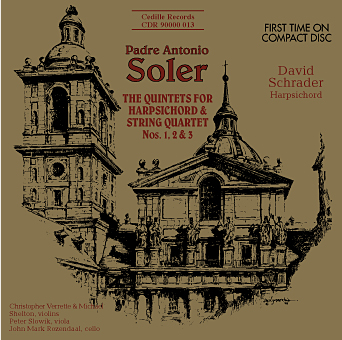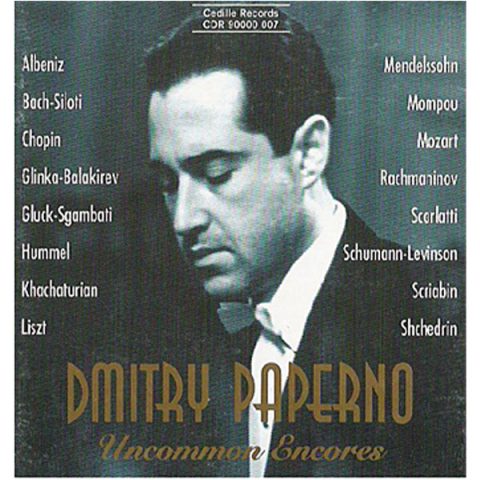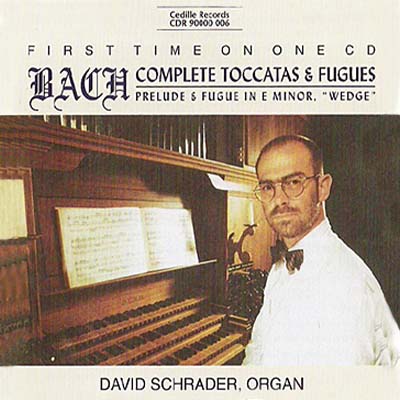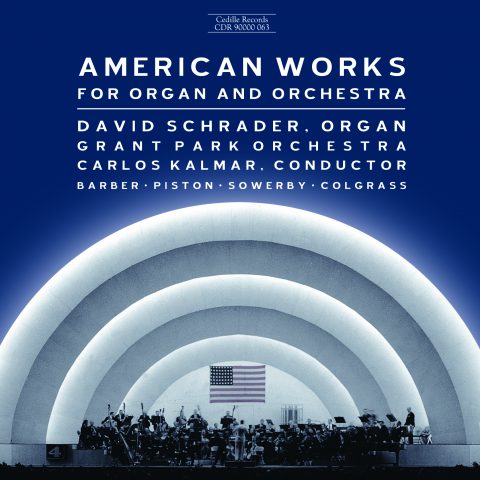| Subtotal | $12.00 |
|---|---|
| Tax | $1.23 |
| Total | $13.23 |
Store
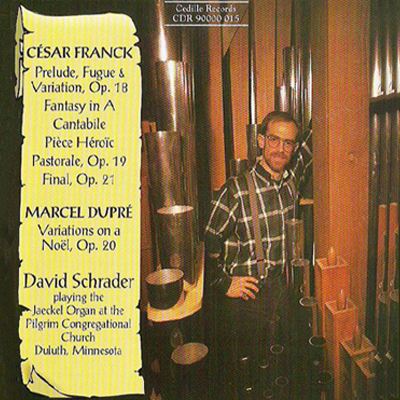
Store
Organ Masterpieces by Franck and Dupré
For his third organ recording on Cedille Records, keyboard artist David Schrader explores the chromatic development of French organ music in a program that characteristically sets out to engage listeners’ intellects.
The intelligently programmed, vivid-sounding recording of music by César Franck and Marcel Dupré is performed by Schrader on the Jaeckel Organ at the Pilgrim Congregational Church, Duluth, Minnesota. Completed in 1988, the organ is modeled on the 19th-century French organs of Cavaillé-Coll.
Schrader’s approach to the Franck Prelude, Fugue & Variation is poignant and lilting, in stark contrast to the fast, mechanical tempos heard on other recordings. Schrader also marches to an unconventional beat with the lovely Cantabile, which Cedille producer Jim Ginsburg says is usually performed too sluggishly. On Dupré’s playful “Variations on a Noël”, Schrader makes the most of the music’s almost carnival calliope aspects, taking the listener on a vertiginous, dreamlike carousel ride, concluding with the tortuous toccata — all performed on a completely mechanical, “suspended” key action instrument. Such an instrument “allows for greater nuance in interpretation and far greater muscular and aerobic exercise,” Schrader writes in the liner notes.
Preview Excerpts
CESAR FRANCK (1822-1890)
MARCEL DUPRÉ (1886-1971)
Artists
Program Notes
Download Album BookletOrgan Masterpieces by Franck and Dupre
Notes by David Schrader
César-Auguste-Jean-Guillaume-Hubert Franck was born in Liège on December 10, 1822. He studied at the conservatory in Liège from 1830 to 1835 and at the Paris Conservatory from 1837-42. While preparing for a career as a virtuoso pianist, Franck became strongly attracted to the organ. He pursued various appointments in Parisian churches, finally becoming the titular organist of the Basilica of St. Clotilde in 1858, where he remained until his death in November of 1890. Franck also served as the professor of organ at the Paris Conservatory starting in the mid-1870s.
Franck was an enormously gifted improviser. Upon hearing Franck at the organ of St. Clotilde, Franz Liszt is said to have remarked, “This man is either the devil himself or a reincarnation of J.S. Bach!” Another account states that some of Franck’s finest compositions died against the walls of St. Clotilde. In any event, Franck’s love for the instrument and his original genius helped him found the “French Symphonic” school of organ playing: an aesthetic which combined the bold, vibrant colors of the nineteenth-century French organ — especially as represented by the instruments of Aristide Cavaillé-Coll (1811-1899) — with strict methodology in composition (both written and improvisational) and execution.
Franck’s use of the organ has been called “orchestral.” Franck is known to have referred to the organ at St. Clotilde as his “orchestra,” and his fondness for stops of unison pitch in various configurations is evident throughout his organ music. Franck also introduced a more serious character to French organ music than that of his immediate predecessors and contemporaries, such as Lefébure-Wély (1817-69), who wrote in a lighter vein. The solid musical structure and great wealth of invention exhibited in Franck’s music became hallmarks of both the improvised and written compositions of later French composers, most notably Charles-Marie Widor (1844-1937) — who succeeded Franck as professor of organ at the Paris Conservatory — and Marcel Dupré (1886-1971), whose improvisations have been called “musical miracles.”
Franck published the collection known as the Six Pièces — Fantasy in C, Op. 16; Grande Pièce Symphonique, Op. 17; Prelude, Fugue and Variation, Op. 18; Pastorale, Op. 19; Prière, Op. 20; and Final, Op. 21 — in 1868. It was, without doubt, the greatest contribution to French organ repertoire in over a century and arguably the most significant organ collection composed in the nineteenth century. Said Liszt of the Six Pièces, “These poems have their place beside the masterpieces of Sebastian Bach.”
The Prelude, Fugue and Variation is probably Franck’s most popular piece for the organ. The beauty of the wistful melody and the spare texture within which it is treated contrast wonderfully with the richness of the fugue — the piece cannot fail to evoke a poignant emotional reaction from the listener. My experience with this music has always been a profound and intense one precisely because of its innate simplicity. The old saw that “still waters run deep” rings most truly here. Unique among Franck’s compositions is his use of the hautbois register (which generally figures among the fonds, or foundation stops, seldom used for solo melodies) here as a solo color ideally suited to the plaintive tune. Franck gave the Prelude, Fugue and Variation its first performance on November 17, 1864, and dedicated the work to Camille Saint-Saëns.
In 1878, the Palais du Trocadero was built for the Universal Exposition. Its central building, called the Salle des Fêtes (Festival Hall) was a five-thousand-seat auditorium that contained a large organ by Cavaillé-Coll — the first large instrument ever installed in a French concert hall. The completion of the instrument was celebrated by a series of fifteen inaugural recitals given by the most famous organists in France at the time: Guilmant, Gigout, Dubois, Widor, and Saint-Saëns all performed, as well as Franck, who played the thirteenth concert of the series on October 1. Franck’s concert included the premiere performances of the Trois Pièces — the Fantasy in A, Cantabile, and Pièce Héroïque. These three works were not performed as a set, however, but were interspersed with other selections. The Trois Pièces were apparently composed in an astonishingly short time — they are dated from the tenth to the seventeenth of September — and in the following order: Fantasy, Pièce Héroïque, and Cantabile.
The Fantasy is the longest of the Trois Pièces. Gently moving, but never hurried, it reflects the maxim that Franck’s organ music often sings but rarely dances. The piece makes use of many beautiful sonorities, particularly of the otherworldly vox humana register. The heroic climax toward the end features a combination of two themes heard early in the piece. Although the mode of the Fantasy is A major, the work ends in A minor.
The Cantabile is one of the most beloved of Franck’s organ works. Described by composer Vincent d’Indy (1852-1931) as “suave and devotional,” it was played at Franck’s requiem mass by Eugene Gigout, who was chided by one critic for playing too quickly and without the proper expression. It would, however, be equally inappropriate to perform the work so slowly as to render it maudlin. Accordingly, I have chosen a tempo that maintains the flow of the piece while still allowing enough time to smell the roses along the way.
The Pièce Héroïque is cast in the large ternary form of which Franck was demonstrably fond (four of the six Franck works recorded here are cast in this form). The piece features a brooding, sinister-sounding opening theme accompanied by repeated notes. Some have heard this dramatic work as an expression of tribute to the fallen soldiers of the Franco-Prussian war of 1871, and a few writers have dubbed the work’s B major middle section the “oasis theme.” Nevertheless, there is really no evidence of extra-musical story-telling going on here. (I am reminded of Arturo Toscanini’s famous insistence during a rehearsal of Beethoven’s Fifth that the opening bars are not “fate knocking at the door” but rather “Allegro con brio!”) Franck altered the published ending slightly from that which he is known to have performed at the Trocadero in 1878.
Franck completed the Pastorale on September 29, 1863 (as with all of the Six Pièces, the work was first published in 1868) and dedicated it to Cavaillé-Coll, the builder of the organ at St. Clotilde. The piece has no particular program; its chief claim to “pastoral” status stems from the use of pedal points in the opening and closing sections. The usual compound meter and lilting, conjunctly-moving melodies employed by composers (especially those of seventeenth and eighteenth century Italy and also J.S. Bach) to evoke sheep, shepherds, and other bucolic images are entirely absent here. Among Franck’s organ works, the registrations are unusually simple and few in the Pastorale. Written for only two keyboards and pedal, the piece uses a total of eight stops and only two changes of registration. Franck gave the Pastorale its public premiere on November 17, 1864.
Of the pieces on this recording, the Final (despite its opus listing as the last of the Six Pièces) appears to be the earliest in date. It was probably among the solos that Franck played at the inauguration of the Cavaillé-Coll organ at St. Clotilde on December 19, 1859. The Final is dedicated to the then-popular virtuoso Lefébure-Wély, whose formidable pedal technique may have inspired the pedal solos with which the piece opens. Vincent d’Indy, Franck’s student and biographer, found the Final “particularly interesting because of its firm, Beethoven-like structure, its graceful second theme contrasting with the inflexibility of the first and the important development toward the close which leads to a forceful and majestic peroration.”
Marcel Dupré was among the primary figures of twentieth-century French organ music. Everything about Dupré seems to reflect the prodigious. In 1920, he performed the complete organ works of Bach from memory in a grueling series of ten recitals. His list of compositions and discography also attest to his extraordinary productivity. In addition to his impressive catalog of written works, he was renowned for creating improvisations that were logical, beautiful, and generally astonishing in their scope and invention. The teacher of an entire generation of French and American organists (among his celebrated pupils were Olivier Messiaen and Marie-Claire Alain), Dupré’s influence remains with organists today.
Variations on a Noël is probably Dupré’s best-known and most beloved work. Composed in 1922, it is based on the tune, Noël nouvelet, an old French noël actually associated with Easter and spring rather than Christmas. The set of ten variations (which follow an initial statement of the theme) are a veritable compendium of virtuoso devices such as rapid consecutive thirds in the right hand, bravura pedal passages, and the fiery staccato chords in the concluding toccata. The colors of the organ are well exploited — Dupré indicates them specifically, and the magnificent Jaeckel organ heard on this recording more than does them justice. There is, however, one particular aspect of this instrument which does not comply with Dupré’s intentions: the action. The organ heard here is completely mechanical with regard to registration and playing action, making the execution of Dupré’s tempos rather a challenge — far more so than on pneumatically assisted or electric actions. While this is not historically defensible, I would point out that just as more air is beaten into cream and eggs with a wire whisk, the use of mechanical playing action allows for greater nuance in interpretation and far greater muscular and aerobic exercise!
— David Schrader
Album Details
Total Time: 67:20
Recorded: March 10 & 11, 1993, Duluth, Minnesota
Producer: James Ginsburg
Engineer: Bill Maylone
Front Cover: David Schrader inside the organ chamber. Photo by Eric S. Lieber
Design: Cheryl A Boncuore
Notes: Easley Blackwood
© 1993 Cedille Records/Cedille Chicago
CDR 90000 015
